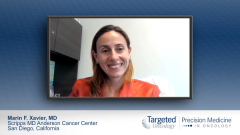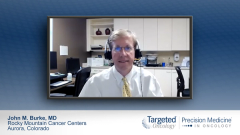
CAR T Cells in R/R DLBCL
Recommendations to increase the uptake of CAR T-cell therapies into clinical practice when managing patients with relapsed/refractory diffuse large B-cell lymphoma.
Episodes in this series

Marin F. Xavier, MD: We talked about loncastuximab and LOTIS data, LOTIS-1. There’s 1 more thing that’s out there to be aware of. LOTIS-8 is being tested in newly diagnosed patients, but I haven’t reviewed that yet. Be on the lookout for that to be reported. Of course, when I introduce myself, I always say I’m a recovering stem cell transplanter, and neither 1 of us is an actual cellular therapy prescriber. We’re referring physicians for cellular therapy. With that in mind, take our insights with a grain of salt. We represent—I wouldn’t say community, because Dr. Burke is amazing and impressive. I love this discussion learning. You know the data so well, but we’re not the ones managing toxicities, grading the ICANS [immune effector cell-associated neurotoxicity syndrome] score for neurotoxicity, cytokine release, and stuff like that. We come to this discussion from a prescriber’s perspective.
That being said, the other big area for all of us is where does CAR [chimeric antigen receptor] T-cell therapy fit in? We’ve talked about it a little in the beginning in our fit vs unfit. I will just say that if somebody is eligible for a curative therapy, they need to be referred and considered for that therapy. Loncastuximab, tafasitamab-lenalidomide, polatuzumab, and all these other new things are not curative therapies. Looking at all the major products, we have the ZUMA trial, JULIET, and TRANSCEND NHL 001, which is the liso-cel [lisocabtagene maraleucel]—I call it the Kite, the Novartis, and the Juno. These are the 3 options. If you look at big picture from a prescriber standpoint, of those patients, maybe 40% to 50% can be cured from CAR T in this setting, and it’s currently for third line. My general perspective is that anybody who can be considered for that should not be deprived of potentially curative therapy. What do you think, John?
John M. Burke, MD: No question about it. I agree 100%.
Liso-cel, tisa-cel [tisagenlecleucel], and axi-cel [axicabtagene ciloleucel]. You made an important point earlier that very few patients who are eligible for CAR T-cell therapy receive it. It was in 1 of the ASH [American Society of Hematology] journals within the last year. Since CAR T was approved for DLBCL [diffuse large B-cell lymphoma], about 2000 patients have been treated with it. Within the last year I saw that in writing, so that’s not many if you think about how many relapsed large cell lymphomas have happened in the United States over the last 2 years since CAR T became available. It’s important, as you say, to think about it, to offer that to patients as a potentially curative option, and to make every effort you can to get your patients to it.
There’s a reason that not that many patients have gotten it or many reasons, including all the barriers—the insurance hurdles, the cost, the potential toxicities might scare some patients away, the need to travel to selected centers, the lack of wide availability, many potential barriers to it. That does open the door for some of these newer therapies that, as you say, may not be curative. I’m a little cautious on saying that because chemotherapy alone can be curative. If you go back and look at the old PARMA trial, there’s a tail on that curve even in the chemotherapy arm. Tafasitamab-lenalidomide sure has pretty good PFS going out at 3 or 4 years. Even polatuzumab-bendamustine-rituximab has a percentage of patients who haven’t relapsed after getting that treatment. CAR T-cell therapy does appear to be the leader in terms of potential for cure in relapsed DLBCL.
Marin F. Xavier, MD: I don’t think either 1 of us wants to look in depth at axi-cel, tisa-cel, and liso-cel. We all seen those trials out there for a while. The new kid on the block is the liso-cel, and that FDA approval was almost 2 years after the other 2. That may be interesting in terms of outpatient because they have a lot more data there. Steve Schuster, 1 of my mentors from fellowship, did try to compare tisa-cel and liso-cel. There was no real measure; it was not prospective. Looking at the data, there was no significant difference in outcomes between those 2 products. More data are needed in terms of comparing these head-to-head.
I’m excited about the allogeneic ones as well, maybe having an off-the-shelf version that decreases the processing time. That may be more accessible to people in the community or who aren’t able to travel. My dream is to not need FACT [Foundation for the Accreditation of Cellular Therapy] certification to do that because my background is as a transplanter. It would be good for remote areas if that could be a product in the future. The [University of Texas] MD Anderson [Cancer Center] data looking at those NK [natural killer] allogeneic products look really exciting.
We have these 3 available, and the hope is that No. 1, in my opinion, we can move up to second line for those wham-bam-thank-you-ma’am, chemotherapy-refractory patients who you know aren’t going to be cured with an autotransplant, and then getting people fast enough and bridging them to CAR T. You don’t disagree, John, that if somebody is potentially a candidate, they should try to get it if possible.
Transcript edited for clarity.








































